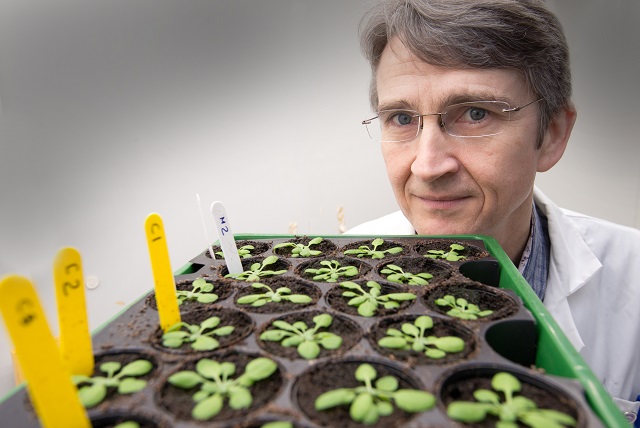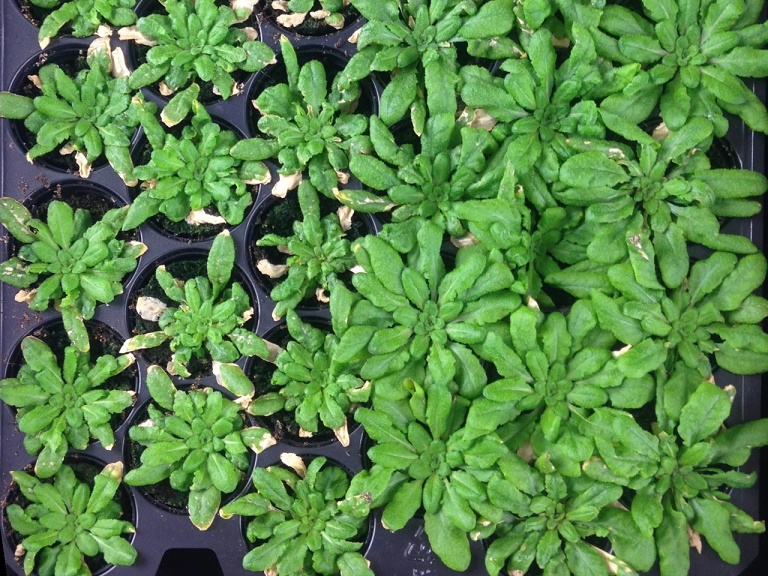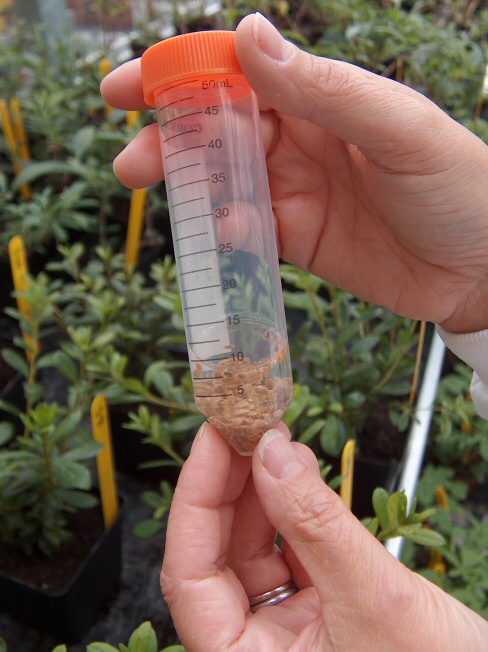This week’s blog post was written by Dr. Mike Roberts (Lancaster University, UK).

Dr. Mike Roberts, Lancaster University, UK, Mike with an experiment to test the effects of parental herbivory on defense priming in the next generation of Arabidopsis plants. (Photo credit: Lancaster University)
It is widely accepted that achieving agricultural sustainability means reducing our reliance on synthetic agrochemicals. One major group of agrochemicals is pesticides, which include the insecticides and fungicides that protect crop plants against pests and diseases. Pests and diseases aren’t going to go away, so reducing pesticide usage means that alternative crop protection approaches are needed. EU Directive 2009/128/EC (Sustainable Use of Pesticides) recommends the use of integrated pest and disease management (IPM) – the combined use of multiple approaches that together provide sufficient protection.
Our contribution to this challenge has been to identify ways in which we might enhance a plant’s own natural defense mechanisms. Plants have a wide array of structural and chemical defenses that they can employ to fight off enemies. Many of these are inducible, meaning that they are only activated in response to attack, which allows plants to balance the costs and benefits of defense. For crop plants, these costs can often translate into reduced yields. Spraying with compounds that switch on inducible defenses, such as the plant hormones jasmonic acid (JA) and salicylic acid (SA), can make plants more resistant, but this approach also risks unwanted growth reductions.

(Left to right) Jane Taylor, Mike Roberts and Nigel Paul, who led the research on defense priming using seed treatments, in the glasshouse at the Lancaster Environment Center. (Photo credit: Lancaster University)
Fortunately, evolution has produced another way of regulating inducible defenses that we can take advantage of: the phenomenon we refer to as ‘priming’. When we ourselves get infected with something like a virus, our immune system generates antibodies to quickly fight it off, but it also produces memory cells that can respond to the same infection many months, or even years, in the future, with a more rapid and effective immune response. This is the basis of the familiar concept of vaccination. While plants don’t make antibodies, they are nevertheless able to alter future patterns of defense activation in response to previous infection by disease or feeding by herbivorous insects; thus, priming results in a faster and stronger activation of future inducible defense responses.

Transgenerational immune priming enhances disease resistance in Arabidopsis. All the plants in the photograph were inoculated by spraying the whole tray with a suspension of Pseudomonas syringae bacteria. The plants on the right side of the photo are from seed collected from parent plants that were infected with the same P. syringae bacteria, whilst those on the left come from healthy parents. (Photo credit: Belinda Ameyaw)
If we can find ways to prime defenses in crop plants, we might be able to improve pest and disease resistance with minimal impacts on yield. One way to do this is through seed treatments. We found that treating seeds with the defense hormone JA provides long-term enhanced resistance against herbivory and some fungal diseases, without affecting growth and development. We were able to patent this discovery, and the approach has since been successfully commercialized. The same approach can also be used to prime defenses against other forms of biotic and abiotic stress.

Tomato seeds being treated with jasmonic acid solution. (Photo credit: Lancaster University)
How and why seed treatments provide long-term defense priming can be explained by the phenomenon of transgenerational immune priming, which my lab has also been investigating. After our success with the seed treatment, we wondered, “What if seeds were exposed to hormones like JA during the course of their development on the parent plant?” We tested this by infecting plants with bacteria or exposing them to herbivores, and then examined defense in their offspring. Remarkably, we saw that priming responses established in the parent were passed on to the offspring; something we refer to as transgenerational immune priming.
The evidence we have at present suggests that the mechanism for this heritable stress memory is epigenetic, meaning the genes that control priming are chemically tagged to alter their activity. These epigenetic modifications don’t involve changes in the DNA sequence and are reversible, allowing rapid, flexible responses to environmental stress. Understanding the nature of these epigenetic changes may provide another way to exploit priming for crop protection. Introducing the right epigenetic marks onto genes in elite crop varieties may enable the priming of defense without altering their genetic make-up. Given the difficulty of introducing new chemical and biological methods of crop protection, which require time-consuming and costly regulatory approval before they can be brought to market, this could prove an especially attractive option in the future.





